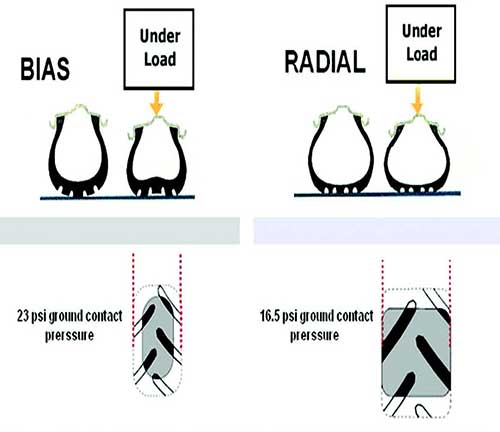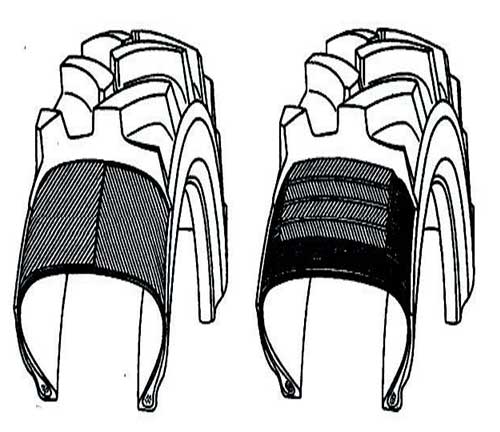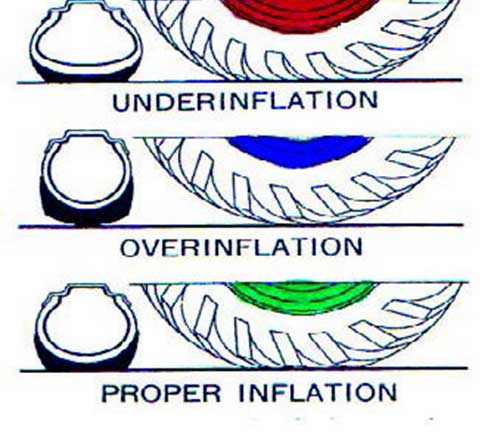There’s a lot to think about when it comes to the selection and use of tractor tyres. Numerous studies show many farm tractors aren’t optimally ballasted and are often overweight for the way they are used.
Farm tractors with internal combustion engines were equipped with steel wheels for their first 40 years.
They gained traction with rigid steel or cast iron lugs bolted on to the wheel rims for traction.
The change to pneumatic tyres began in 1932 with the Firestone/Allis-Chalmers, one of agriculture’s most effective innovations. Adoption was swift.
Apart from the initial purchase price, one advantage steel wheels did have, as pointed out by a Mallee farmer, was “the ease with which they can be released from a bog, as compared with rubber, because a pole can be placed under the spikes to allow the tractor to lift itself out”.
The initial farmer reaction to pneumatics on tractors was deep skepticism.
After all, rubber tyres were much more expensive than steel wheels.
Machinery dealers would resort to delivering tractors with rubber when steel had been ordered — with a promise to replace the rubber in a week if the customer still wanted to go back to steel. Few ever did.
 |
|
When correctly inflated, radials perform better in transferring power to the ground and last longer than bias ply tyres.
|
GETTING TRACTION
The first point to make about tractors is that no matter what traction devices are used to propel a prime mover across the land, they all need some soil movement to ‘get a grip’.
That is, no matter how small, there must be some slippage.
Traction is defined as the force derived from the interaction of the device with the ground surface.
Soil is complex.
In farming, a traction device that develops the necessary traction is of little use if at the same time the machine compacts the soil excessively or creates severe ruts impeding crop
production or there’s erosion due to wheel tracks.
Pneumatic tractor tyres have the following functions and demands:
- Carrying loads. The vertical forces are weight, ballast and transferred implement forces; longitudinal forces comprise implement draft and braking; and lateral forces due to cornering and side slopes.
- Elasticity to reduce vibrations and improve ride
- Serve as containers for fluid ballast
- Self-cleaning, to remove soil build-up between lugs
- Minimise soil compaction and ground surface damage.
- Long wear life
- Tough, insensitive to sharp obstacles and staking.
- Setting up a tractor correctly is a balancing act between a wide array of choices. Correct choices reduce operating costs, maximise performance and increase tractor life. How do you ensure a tractor is set up to work at it’s best, as far as tyres are concerned?
FOUR BASICS
The basic choice is between radial or bias ply construction. The four basics of
tyre choice and set-up are:
1. Tyre type
2. Tyre size
3. Number of tyres
4. Tyre operating inflation pressure — matched to load.
 |
|
Tyre construction. The two principle types in tractor applications are bias ply (left) and radial ply (four-ply radial, right).
|
BIAS VERSUS RADIAL PLY
Plies are layers of relatively inextensible cords or wire embedded in the rubber to hold its shape by preventing the rubber from stretching in response to the internal pressure.
The orientation of the plies plays a large role in the performance of the tyre and is one of the main ways they are categorised. Bias ply tyres cost less.
The bias or cross ply construction utilises body ply cords that extend diagonally from bead to bead, usually at angles in the range of 30 to 40 degrees. Successive plies laid at opposing angles form a crisscross pattern to which the tread is applied.
The design allows the entire tyre body to flex easily, providing the main
advantage of this construction – a smooth ride on rough surfaces.
The cushioning characteristic also causes the major disadvantages of a bias tyre: namely, increased rolling resistance and less traction than a radial. Radials last longer.
Correctly inflated,radials perform better in transferring power to the ground and last longer
than bias ply tyres.
Radials do require more careful pressure management than bias ply tyres.
It’s not good enough to go by the look of a radial when assessing whether it’s
inflated correctly.
Radial tyres have belt plies which run under the tread at about 15 degrees to the circumferential direction.
These belt plies stiffen, stabilise and strengthen the tread area, minimising tread movement during contact with the ground surface and therefore improve tread life. Radial tyres have a concentrated sidewall bulge at the contact point, even with proper inflation.
Radial tyre construction is recognised worldwide for its ability to deliver numerous benefits bias ply tyres cannot.
In the agricultural industry, radial technology delivers these benefits: Long tyre life, and lower rolling resistance, better resistance to cuts, punctures and tears, excellent traction, improved handling and fuel economy.
Radial tyre construction utilises body ply cords extending from the beads and across the tread so that the cords are laid at approximately right angles to the centerline of the tread, and parallel to each other, as well as stabiliser belts directly beneath the tread. The belts may be cord or steel.
 |
|
Illustrating the internals of a radial tyre. The tyre’s crown tread and sidewalls are able to function as two independent features; Illustrating the internals of a bias-ply tyre, consisting of multiple overlapping plies. The crown and sidewalls are interdependent since the overlapped plies form a thick layer on both circumferential and side walls that is less flexible but more prone to heating and shorter life.
|
SIZE AND NUMBER
Tyre size and the number of tyres, whether singles, duals or triples, is partially determined by the tractor supplier but also by what the operator wants.
Manufacturers sell tractors with certain options. With used tractors or those ‘in stock’, it may not always work out this way.
To increase efficiency when it comes to tyres, choose radials, choose the largest and affordable ones, and choose enough of them so that there is sufficient load carrying capacity to keep the tyre pressures at 100kPa (14 psi).
It is possible, but uncommon, to have too much tyre capacity on a tractor.
More typically the tyres are the limit to a tractor’s load carrying and power delivery. Ground compaction levels are reduced as the tyre size and number increases but at the same time the area compacted goes up.
SOIL COMPACTION
In the 1950s Walter Söehne in Germany developed the ‘pressure bulb’ theory and modelled stress distribution in soils under tractor tyres.
This showed compaction under the upper soil is mainly governed by tyre contact pressure, whereas compaction in the lower soil layers is mainly a function of tyre loading.
Also, compaction for a given soil stress state is higher for wet soils than for dry soils. Reducing contact pressure meant larger tyres and lower inflation pressures.
Soil contact pressure is typically a little higher than inflation pressure depending on carcass stiffness.
The pressure bulbs show the stress distribution in kPA under the tractor tyre with a given load exerting a ground pressure of 90kPa (13 psi) on three different soil conditions:
1. Left: Hard and dry
2. Middle: Average workable
3. Right: Wet and soft soil.
Soil stress is slightly higher in the upper layer than the tyre’s inflation pressure and soil compaction dependent on tyre inflation pressure, 13 psi in this instance. Compaction effects can penetrate down to several feet under the wettest conditions. Deep compaction effects from over-ballasted tractors and from transporters carrying heavy loads can last for years. On the deeper layers compaction is mainly a function of tyre loading.
Plant response to compaction is mainly governed by the plant’s growth stage, soil moisture and load.
TYRE INFLATION
Deflating a tyre for off-road softens it, making the tyre more flexible to absorb bumps and less likely to get punctured by sharp objects. It increases the contact patch with the ground, or footprint, increasing traction and rotation. The pull of a traction tyre is usually increased by deflating the tyre when operating on sand, but it may have no effect on stiff clay.
On concrete, the additional flexing may actually decrease the tyre’s power efficiency by deflation.
 |
|
Influence of tyre pressure. It is difficult to determine if a radial tyre is underinflated just by looking.
|
WHEEL SLIP
Wheel slip is the same but not identical to travel reduction — that is, the reduction in forward speed due to slippage that occurs when a tractor pulls a drawbar load. A tractor can’t develop drawbar pull unless there is travel reduction to some extent. The tyre lugs must move rearwards and compress the soil to make it strong enough to support the tractive force; the rearward movement of the lugs and the consequent shearing of the soil causes travel reduction. For two-wheeled tractors 10 to 15 per cent ‘slip’ is optimal.
Excessive slip of course means less work done, soil damage, tyre wear and higher fuel consumption.
BALLASTING
If traction was the only consideration, a tractor would be ballasted to put all the weight on the drive axle and wheels. But for a two-wheeled tractor enough weight is needed on the unpowered front axle to permit steering control.
Ballasting tractors is a trade-off between the costs of ballasting and extra fuel consumption versus the costs of tyre wear and labour needed to remove the ballast when not needed.
Excess ballast results in soil compaction and reduced yields, especially on clay soils at high moisture contents.
As a rule of thumb, for a 2WD tractor 25 to 30 per cent static weight on the unpowered steering axle ensures enough dynamic weight on the steering to maintain directional control.
The same for front-wheel assist (FWA) tractors when the FWA is disengaged.
For 4WD ballast approximately 55 to 60 per cent of the static weight on the front axle so that with dynamic weight transfer about half the dynamic weight will be on each axle.
The same for FWA as 4WD when the front axle is engaged.
Start with the operator’s manual to learn an individual tractor’s ballasting constraints and use only enough weights to obtain good performance with traction and stability as key.
OVERWEIGHT TRACTORS
Tyre ballast is important. Tractors cannhave more power than their base weightncan use so adding weight to the tyresnand/or frame will improve traction and reduce wheel slippage, which can damage tyres.
There is evidence that the use of rim weights can lead to transmission problems long-term compared with liquid in the tyres to the same weight.
One thing is clear: the use of cast iron wheel weights allows more flexibility in being able to add or remove the ballast according to the job at hand.
Certainly never fill above 90 per cent, otherwise there will be insufficient air space to absorb shocks and damage to the tyre can occur. If more ballast is needed, better to stop at 75 per cent,which is slightly above valve stem level.
Filling a 30.5-32 tyre to 75 per cent can add one tonne (2,200lb) to that wheel. Calcium chloride is heavy (30 per cent more than water alone), will not freeze and is fairly inexpensive, but it is extremely corrosive. It can eat holes in the rim or just about anything else.
 |
|
The Dana Spicer CTIS allows better trafficability in varying terrain and also maintains pre-determined tyre pressure over time. Air is pumped in through the axle and not externally. Because of initial costs this ideal set-up for matching inflation to terrain or load is primarily being adopted on military hardware.
|
DUAL WHEELS
Fitting dual wheels increases traction by providing a greater soil contact area, permitting more ballast and reduced sinkage.
All else being equal, duals may increase the average pull of a tractor drive axle by more than 30 per cent.
TYRES FOR CONTROLLED TRAFFIC FARMING
In controlled traffic farming (CTF) permanent wheel tracks are reserved to confine machinery to specfic ‘road beds’, keeping the wheels out of the cropping zone so as to avoid disturbing any plants.
It’s no longer necessary to minimise tyre pressure and consequential soil compaction in the road beds.
Higher pressure helps roll down the tracks, resulting in less rolling resistance and better trafficability for subsequent passes.
There are even special very high load agricultural tyres for CTF. For example, a Goodyear Special Grip VA500/95D32 20-ply rating has a maximum allowable pressure of 415kPa (60psi) and load rating of 9,580kg, compared with the 520/70R38 with maximum allowable pressure of 160kPa (23psi) and load rating of 3,350kg.
The Special Grip does require a split rim.
Generally, the full drawbar power isn’t used in CTF so the tractor doesn’t need to be fully ballasted.
PARTING WORDS
Proper tyre management means setting an appropriate load for the tyre and the proper inflation for that load.
For optimum performance, tyres need to be run at the lowest recommended pressure for the weight they carry.
This translates to the optimal footprint or area of rubber in contact with the ground and transfer of power to the ground.
Using the correct in ation also minimises soil compaction for the specific tyre and load. Finally, do you have an accurate tyre gauge?
If you’re looking for tractor accessories for sale, check out our listings.
Photography: Colorado Components


